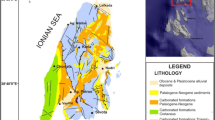Abstract
Jerusalem is located 25 km from the active Dead Sea fault, which is a part of the Dead Sea Rift System Despite its proximity to the fault, the city has escaped past seismic events relatively undamaged. In contrast to the rest of the city, the Mount of Olives did suffer damage as a result of landslides, as evidenced by a large landslide scarp found in the western slope The unstable slopes in Jerusalem are located on soft Senonian chalk. In the past, these areas were left undeveloped and as a result, damage from earthquakes was relatively slight However, during the past 15 years, with the expansion of Jerusalem, construction has been taking place on unstable slopes as well This could result in heavy damage during future earthquakes A map showing the areas of highest risk is presented. It is recommended that the unstable slopes be reserved as green areas.
Similar content being viewed by others
References Cited
Arieh, E. J., 1967, Seismicity of Israel and adjacent areas: Geol Surv. Isr. Bull. no. 43, 14 p.
Arkin, Y., 1976, Jerusalem and vicinity geological map 1∶50000: Geol. Surv. Isr.
Ben-Menachem, A., and E. Aboodi, 1981, Macro- and microseismicity of the Dead Sea Rift and off-coast Eastern Mediterranean: Tectonophysics, v. 80, no. 1-4, p. 199–233.
Israeli, A., 1977, Geotechnical map of Jerusalem and surroundings, scale 1∶12500: Geol. Surv. Isr. Rep. MM/12/77, 46 p.
Shalem, N., 1949, The seismicity of Jerusalem,in Benvenisti, D., 1973, Nathan Shalem, Collection of papers: Jerusalem, Qiryat Sefer, 711 p. (in Hebrew).
Shapira, A., 1981, Assessment of the potential earthquake risk in Israel and adjacent areas: Isr. J. Earth-Sci., v. 30, no. 4, p. 135–141.
Vered, M., and H. L. Striem, 1977, A macroseismic study and the implications of structural damage of two recent major earthquakes in the Jordan Rift: Bull. Seismol. Soc. Am. v. 67, no. 6, p. 1607–1613.
Vered, M., 1978, The probable maximum earthquake magnitude associated with the Jordan Rift: Isr. J. Earth-Sci., v. 27, no. 1-D2, p. 82–84.
Wachs, D., and D. Levitte, 1978, Damage caused by landslides during the earthquakes of 1837 and 1927 in the Galilee region: Isr. Geol. Surv. Rep. Hydro/5/78, 13 p.
Wachs, D., and D. Levitte, 1981, Earthquake-induced landslides in the Galilee: Isr. J. Earth-Sci., v. 30, no. 1, p. 39–43.
Willis, B., 1928, Earthquakes in the Holy Land: Bull. Seismol. Soc. Am., v. 18, no. 2, p. 73–102.
Author information
Authors and Affiliations
Rights and permissions
About this article
Cite this article
Wachs, D., Levitte, D. Earthquake risk and slope stability in Jerusalem. Environ. Geol. Water Sci 6, 183–186 (1984). https://doi.org/10.1007/BF02509912
Issue Date:
DOI: https://doi.org/10.1007/BF02509912




